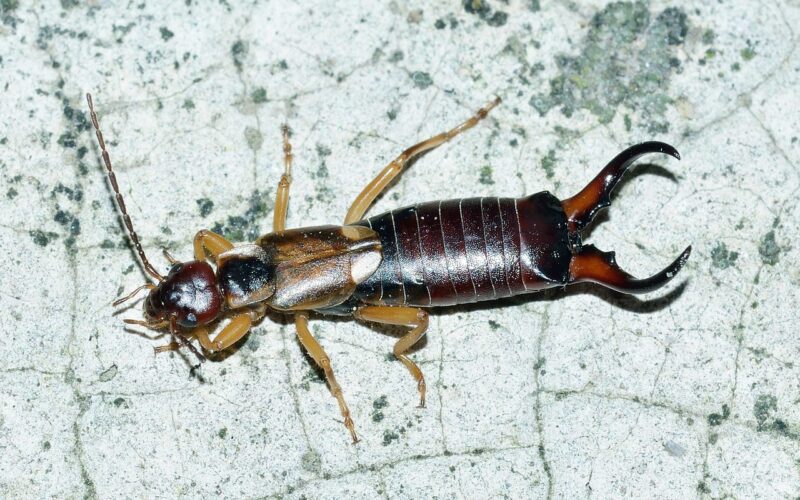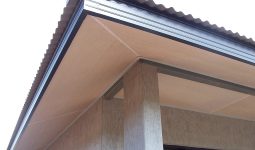Spotted earwigs scurrying around your home? Don’t worry – these pincer-tailed insects might look scary, but they’re manageable with the right approach.
You can get rid of earwigs in your house by using simple solutions like a rubbing alcohol spray (equal parts alcohol and water) for immediate removal, or by placing DIY traps made from oil-filled containers around problem areas.
While these nocturnal creatures don’t actually crawl into ears despite their name, they are attracted to dark, moist environments in your home.
Understanding why earwigs enter your house is key to preventing them.
They typically come indoors seeking shelter from extreme weather or looking for food.
By reducing moisture around your foundation, sealing entry points, and turning off outdoor lights that attract them, you can make your home less inviting.
Remember that while earwigs might be a nuisance, they’re actually beneficial to the ecosystem outside your home.
What Earwigs Are And Why They Enter Homes
Earwigs are small, nocturnal insects with elongated bodies and distinctive pincers at the end of their abdomen. Despite their frightening name, they won’t actually crawl into your ears while you sleep!
These garden pests typically measure between 5-25 mm long and have a reddish-brown to black coloration. Their most recognizable feature is the pair of forceps-like pincers (cerci) they use for defense and catching prey.
Diet and Behavior:
- Feed on both plant and animal matter (omnivores)
- Consume decaying vegetation, other insects, and plant materials
- Most active at night (nocturnal)
- Not harmful to humans or pets
Earwigs enter your home primarily seeking moisture and shelter. They’re naturally drawn to dark, damp environments, which is why you’ll often find them in basements, crawl spaces, and bathrooms.
The two main reasons earwigs invade houses are:
- Weather conditions – During dry spells, they seek moisture inside homes
- Easy entry points – They slip through cracks in foundations, gaps around windows, and under doors
Your home’s structure provides plenty of hiding spots earwigs love. They’re particularly attracted to water-damaged wood and areas with high humidity.
You might notice more earwigs indoors after heavy rainfall, as flooding drives them to seek higher ground and new shelter.
Signs Of Earwig Infestation And Where To Find Them
Spotting the signs of an earwig infestation early can help you tackle the problem before it gets worse. The most obvious sign is seeing the actual insects in your home.
Earwigs have distinctive pincers (forceps) on their rear end and long antennae. They’re usually reddish-brown and about ¼ to 1 inch long. You might spot them scurrying away when you turn on a light at night since they’re nocturnal creatures.
Look for damaged plants both inside and outside your home. Earwigs create irregular holes in plant leaves and can damage flower petals. This damage is particularly visible on houseplants if earwigs have made their way indoors.
You might also find shed exoskeletons around your home. Earwigs molt as they grow, leaving behind their old skin in places they frequent.
Where to Find Earwigs:
- Dark, damp areas like bathrooms and basements
- Under sinks and around plumbing fixtures
- Inside cardboard boxes and stacked newspapers
- Around crawl spaces and foundation cracks
- In houseplants, especially ones recently brought in from outside
Outdoors, earwigs prefer moist environments like:
- Under mulch, stones, and landscape timbers
- In leaf litter and garden debris
- Inside wood piles and decaying organic matter
- Around compost heaps and garbage containers
- Under flowerpots and garden ornaments
Look for earwigs in the evening using a flashlight, as this is when they’re most active. Pay special attention to these areas when checking for an infestation.
Natural And DIY Removal Methods
Earwigs can be a nuisance, but you don’t need harsh chemicals to get rid of earwigs from your home. These pincher bugs respond well to simple, natural solutions.
Soapy Water Spray works as a natural insecticide. Mix 1 tablespoon of liquid dish soap with 1 quart of water in a spray bottle and apply directly to earwigs or areas where they gather.
Creating earwig traps is easy and effective. Roll up damp newspapers and place them in your garden or near entry points in the evening. Earwigs will hide inside by morning, allowing you to dispose of them easily.
The soy sauce trap is particularly effective. Fill a small container with equal parts soy sauce and vegetable oil. The sauce attracts earwigs while the oil traps and drowns them.
Diatomaceous earth provides a physical barrier. Sprinkle this powder around entry points and garden areas to deter earwigs. It damages their exoskeleton when they crawl over it.
For immediate removal, use your vacuum cleaner to suck up visible earwigs. Empty the vacuum outdoors afterward.
A homemade bug spray of equal parts rubbing alcohol and water works instantly on contact. The alcohol bypasses their waxy shell, killing them immediately.
Encourage natural predators like birds, frogs, and certain beneficial insects that feed on earwigs to help control their population naturally.
Remember that earwigs also eat aphids, making them somewhat beneficial to your garden. Focus removal efforts on those that have entered your home.
Chemical And Professional Solutions
If home remedies aren’t working, you might need stronger options to tackle your earwig problem. Pesticides can be effective for serious infestations, but always use them with caution.
Store-bought insecticides that contain pyrethrins or pyrethroids work well against earwigs. Apply these around entry points and areas where you’ve spotted the pests. Always read and follow label instructions carefully.
Boric acid is another chemical solution that can help eliminate earwigs. Sprinkle it along baseboards, under sinks, and in other damp areas where earwigs might hide. This powder dehydrates and kills the insects when they walk through it.
Diatomaceous earth (DE) offers a less toxic alternative. This powder damages earwigs’ exoskeletons, causing them to dehydrate. Apply it around entry points and in crawl spaces.
When to call professionals:
- Your infestation is severe or recurring
- DIY methods haven’t worked after several attempts
- You’re uncomfortable handling pesticides yourself
Professional pest control specialists have access to stronger treatments and can identify hidden entry points you might miss. They can develop a customized treatment plan for your specific situation.
Most pest control companies offer both one-time treatments and ongoing service plans. The cost typically ranges from $100-$300 depending on your home size and infestation severity.
Remember to ask any professional about pet and child-safe options if you have little ones at home.
How To Prevent Future Infestations
Keeping earwigs away from your home starts with controlling moisture. These pests love damp environments, so reducing moisture around your property is crucial.
Use a dehumidifier in basements, bathrooms, and other humid areas. This simple step can make your home much less appealing to earwigs and other moisture-loving bugs.
Seal cracks and crevices around doors, windows, and foundations to block common entry points. Even tiny gaps can give earwigs a way into your home. Check weatherstripping regularly and replace it when worn.
Fix leaky pipes and faucets promptly. Standing water and excess moisture create perfect conditions for earwigs to thrive.
Consider changing your outdoor lighting. Earwigs are attracted to bright lights at night. Try using yellow “bug lights” instead of white ones, or position lights away from entrances.
Keep your yard tidy with these simple steps:
- Move mulch at least 6 inches away from your foundation
- Create a dry soil barrier around your home
- Trim bushes and plants that touch your house
- Remove leaf piles, fallen fruit, and garden debris regularly
Inspect items before bringing them inside. Check for bugs on flowers, vegetables, firewood, and outdoor furniture that you bring into your home.
Store firewood away from your house and elevate it off the ground. This prevents earwigs from using woodpiles as a stepping stone to your home.
When To Call Professionals Vs. DIY Approach
Most earwig problems can be handled on your own with simple methods. DIY approaches work well for minor to moderate infestations where you only see a few earwigs occasionally.
You can try these DIY solutions first:
- Setting up homemade traps with oil and soy sauce
- Using diatomaceous earth around entry points
- Reducing moisture in and around your home
- Clearing debris and leaf piles near your foundation
DIY methods are often effective when combined properly. They’re also less expensive than hiring professionals.
However, there are clear signs when it’s time to call in experts. If you’ve tried multiple DIY methods without success, professionals might be your best option.
Call professionals when:
- Earwigs appear in overwhelming numbers throughout your home
- Multiple DIY treatments have failed to reduce the population
- You can’t locate the source of the infestation
- The problem persists for more than a few weeks
Professional exterminators have advantages over DIY approaches. They can identify the exact source of your earwig problem and have access to stronger chemical treatments not available to consumers.
Pest control specialists can also develop a comprehensive treatment plan that addresses both immediate removal and long-term prevention.
The cost of professional service is worth considering against the time and frustration of repeated failed DIY attempts. Sometimes a combination of tactics works best, with professionals handling the major infestation while you maintain prevention methods.
Conclusion
Dealing with earwigs in your home doesn’t have to be complicated. With the right approach, you can effectively eliminate these pests and prevent future invasions.
Remember that while earwigs look creepy, they don’t actually burrow into people’s ears as old myths suggest. They’re mostly just looking for moisture and shelter in your home.
Try using a simple mixture of equal parts rubbing alcohol and water in a spray bottle for immediate results. This solution bypasses the insect’s protective shell and works quickly.
Reducing outdoor lighting near your home helps too. Earwigs are attracted to light sources, so turning off unnecessary exterior lights can discourage them from approaching.
Seal entry points around your home to block their access. Check for cracks in your foundation, gaps around windows, and openings around pipes.
For ongoing protection, consider using insecticide sprays or dusts in problem areas. Sticky traps or baits containing boric acid can also be effective tools in your earwig-fighting arsenal.
Removing excess moisture around your property will make your home less appealing to these pests. Fix leaky pipes, improve drainage, and reduce humidity in basements and crawl spaces.
With these practical strategies, you can maintain an earwig-free home and enjoy your living space without these unwanted visitors.








